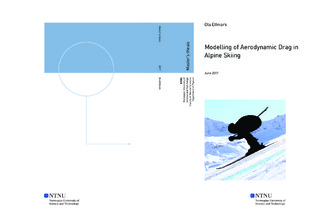| dc.description.abstract | Most of the breaking force in the speed disciplines in alpine skiing is caused by the aerodynamic drag, and a better knowledge of the drag force is therefore desirable to gain time in races. In this study a complete database of how the drag area (CDA) changes, with respect to the different body segments, was made and used to explain a complete body motion in alpine skiing. Three experiments were performed in the wind tunnel at NTNU, Trondheim. The database from a full body measurement on an alpine skier from the Norwegian Ski Federation (NSF), was used to make a numerical model, with the angles in the different body segments as input, to compute the CDA. The model was validated with an uncertainty of ±3%. A new method for calculating the frontal area of an alpine skier inside a wind tunnel was introduced with an uncertainty of ±0.012m^2.
One of the most interesting results presented in this thesis is that the CDA values were increasing when the arm angle approaches zero. This affects some of the flight positions used in competitive alpine skiing, where the athletes are instructed to jump with the arms straight down on the side of the body. Different flight positions were evaluated and possible new flight positions were suggested. The aerodynamic drag in a turning position was discussed briefly with the tendency that the the change in CDA is proportional to the change in the frontal area through the turn. However, ground effects were not taken into account.
The last experiment had four different test subjects from NSF and showed that the percentage change in CDA from the highest to the lowest position was constant and that the drag coefficient(CD) was constant, for the different test subjects. The only parameter one then needs to vary for personal adjustments of the numerical model is the frontal area of the test subjects in the most upright position. By only changing the frontal area as a parameter for the four different test subjects in the numerical model, it still had an uncertainty of ±3%. The results from the wind tunnel and the numerical model were compared to data from a preliminary field experiment, a flight sequence for one of the test subjects. The results from the experiments in the wind tunnel and the numerical model were in accordance with results from the field experiment. | |

